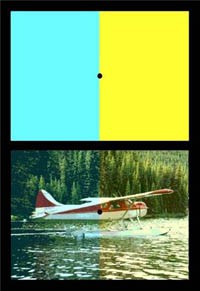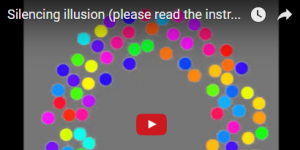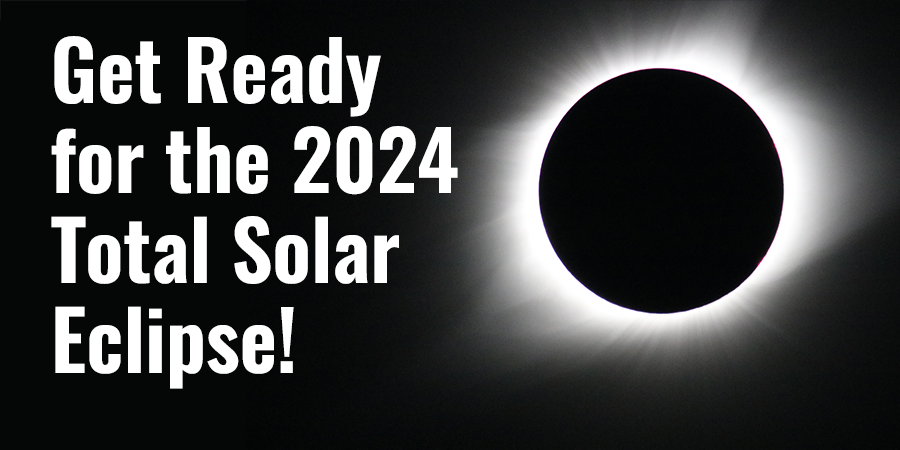Visual Illusions: When What You See Is... Not What's There?
Exploring the science behind what we see and what we think we see. It's not always the same thing!
When you watch the animation above, focus on the white dot in the center. As the surrounding dots begin to spin, do they seem to stop changing colors until the spinning ends? In fact, they continue to change, but the motion of the overall outer ring makes it appear that they stop blinking until the ring stops spinning. If you watch it again and focus on the outer ring, you will see that the colored dots continue to blink and shift color even when the ring spins.
This animation recently won the seventh annual "Best Visual Illusion of the Year" contest, organized by the Neural Correlate Society and associated with the annual Vision Sciences Society meeting. The winning illusion by Jordan Suchow and George Alvarez, a Harvard graduate student and assistant professor of psychology, respectively, is titled "Silencing awareness of change by background motion." It's a simple title for a sensory perception that may also seem simple. But what's simple about the fact that we can think we are seeing something we are not? Nothing!
From studying visual illusions, and the ways in which the brain controls what we perceive, scientists learn more about sensory perception, about the brain, and about vision.
The Science of Visual Illusion
Research in visual illusion and sensory perception involves psychology, physiology, and neuroscience of vision and image processing. Students who are interested in these fields or who simply enjoy the "wow" factor of visual illusions can get more hands-on with the following science projects:

Sleight of Eye
The image above lets you quickly test a non-animated visual illusion. To give it a try, look first at the airplane image. Do you see that the two halves are differently colored? Now, stare at the dot between the blue and yellow rectangles for 20 seconds. Then shift your gaze to the dot in the airplane image. How do the two halves appear now? As you continue to watch, the effect will disappear. (See full project.)
- The Brains Behind 'Where's Waldo?': Create your own visual "find it" game to test the role of "distracters" and how changes in number, size, and color influence difficulty.
- Apparent Motion & Animation: Create flip books to learn more about the way the brain "fills in" motion between a series of static images. Put your love of animation to use by learning more about the science behind the tried-and-true flip book!
- Get the Scoop on Stroop: The color of text makes it harder for people to correctly read the typed name of a color. It's a visual brain twister!
- Now You See It, Now You Don't: A Chromatic Adaptation Project: Explore chromatic adaptation when you use a specifically-colored field to change how the brain will perceive an image.
- Now You See It, Now You Don't: Investigating Inattentional Blindness: Make a video to explore the ways in which focusing on something specific allows you to completely "not see" other things that happen or appear in the same space. There's a zany fun-factor built into this one!
- Warped Words and the Stroop Effect: Can you beat the Stroop Effect by bending the words or otherwise changing their shape or direction?
- Are Your Eyes Playing Tricks on You? Discover the Science Behind Afterimages!: Learn more about color perception, cone cells, and afterimages , the images you see after you focus intently on an image for a length of time and then look away and still see an "imprint" of what you had been staring at.
- I See a Full Moon Rising...and Shrinking...or Do I?: Investigate Emmert's law and the way the moon appears to be bigger at certain points of the night.
Taking it Farther
- A programming environment like Scratch can help you create animated illusions like the one award-winning one featured above. Find out how to get started with Scratch.
- You could also use Scratch to create an I Spy-, Where's Waldo-, or Pictureka-style game. Put what you learn about distracters to use to scale up or down the difficulty!
- Learn more about illusion, perception, and "magic" in Sleights of Mind: What the Neuroscience of Magic Reveals about Our Everyday Deceptions.
- Have you created your own visual illusions? We'd love to see! And if you try one of these projects, be sure and fill out an "I Did this Project" report to let us know how it went.
Categories:
You Might Also Enjoy These Related Posts:
- Plastics and Earth Day - Science Projects
- Arduino Science Projects and Physical Computing
- 10+ Robotics Projects with the BlueBot Kit
- 5 STEM Activities with Marshmallow Peeps
- March Madness Basketball Science Projects: Sports Science Experiments
- Women in STEM! More than 60 Scientists and Engineers for Women's History Month
- Explore Artificial Intelligence and Machine Learning with Student AI Projects
- 10 Reasons to Do the Rubber Band Car Engineering Challenge










